Ecological Sanitation in Uganda - EcoSanRes
Ecological Sanitation in Uganda - EcoSanRes
Ecological Sanitation in Uganda - EcoSanRes
You also want an ePaper? Increase the reach of your titles
YUMPU automatically turns print PDFs into web optimized ePapers that Google loves.
<strong>Ecological</strong> <strong>Sanitation</strong> <strong>in</strong> <strong>Uganda</strong><br />
Treatment technologies for Human Faeces and Ur<strong>in</strong>e<br />
BY DR. CHARLES B. NIWAGABA , PhD: MAKERERE UNIVERSITY, DEPARTMENT OF CIVIL AND ENVIRONMENTAL ENGINEERING<br />
Mix<strong>in</strong>g of compost from the Ecosan toilet<br />
Inc<strong>in</strong>eration of faeces<br />
Faecal treatment:<br />
Faeces are more pathogenic and harder to treat than ur<strong>in</strong>e. Faeces<br />
can conta<strong>in</strong> large concentrations of pathogenic viruses, bacteria,<br />
cysts of protozoa and eggs of helm<strong>in</strong>ths.<br />
Faecal treatment methods <strong>in</strong>clude:<br />
Storage: when excreted faeces are stored <strong>in</strong> the environment at<br />
temperatures below or above human body temperature (37°C)<br />
pathogenic micro organisms die off naturally. Storage of faeces at<br />
low moisture content <strong>in</strong>creases the rate of pathogen destruction.<br />
However, helm<strong>in</strong>ths especially the eggs of Ascaris lumbricoides are<br />
resistant to unfavourable conditions. Therefore recommendation<br />
for a period between one and a half and two years at temperatures<br />
rang<strong>in</strong>g between 2-20°c and one year at temperatures between 20-<br />
35°c.<br />
Compost<strong>in</strong>g: this is the microbiological degradation of organic<br />
material to humus like stable product under aerobic, moist<br />
and self heat<strong>in</strong>g conditions. Dur<strong>in</strong>g this process, a lot of heat is<br />
generated and this is vital <strong>in</strong> sanitiz<strong>in</strong>g the products. For effective<br />
decomposition, there is need to add some organic matter such as<br />
kitchen food waste, constant mix<strong>in</strong>g of the decompos<strong>in</strong>g material.<br />
High moisture (>65%), and low pH (10%, only gasification<br />
takes place, produc<strong>in</strong>g charcoal like substances and a lot of smoke<br />
that smells badly.<br />
Chemical treatment: Chemicals for dis<strong>in</strong>fect<strong>in</strong>g faeces products that<br />
take <strong>in</strong>to account an additional advantage of the agronomic value<br />
of the substances <strong>in</strong> the dis<strong>in</strong>fectants, such as calcium hydroxide<br />
(Ca (OH) 2<br />
), Ammonia (NH 3<br />
), potassium hydroxide (KOH) and<br />
phosphates (PO 4<br />
), are preferable - the nutrient content of the<br />
dis<strong>in</strong>fectant <strong>in</strong>creases the fertiliz<strong>in</strong>g value of the product. Wood<br />
ash and lime are rich <strong>in</strong> calcium and potassium and that is why it<br />
is recommendable to pour them on faeces after us<strong>in</strong>g the ecosan<br />
toilet. Ammonia is also <strong>in</strong>creas<strong>in</strong>gly be<strong>in</strong>g used to treat faeces.<br />
Solar treatment: this method of faecal treatment is commonly<br />
used <strong>in</strong> comb<strong>in</strong>ation with other methods like <strong>in</strong>c<strong>in</strong>eration and <strong>in</strong><br />
prelim<strong>in</strong>ary processes of reduc<strong>in</strong>g moisture content from faeces<br />
collected <strong>in</strong> Ur<strong>in</strong>e diversion dry toilets.<br />
Ur<strong>in</strong>e treatment:<br />
Only a few organisms are excreted <strong>in</strong> ur<strong>in</strong>e and this is usually <strong>in</strong><br />
case of <strong>in</strong>fections. Ur<strong>in</strong>e is almost sterile <strong>in</strong> the human bladder.<br />
Ur<strong>in</strong>e is usually contam<strong>in</strong>ated by organisms from faeces dur<strong>in</strong>g<br />
the collection processes for example <strong>in</strong> the ur<strong>in</strong>e diversion toilets.<br />
Ur<strong>in</strong>e can easily be treated by storage. After perform<strong>in</strong>g laboratory<br />
experiments at various temperatures, it is recommended to store<br />
ur<strong>in</strong>e at near room temperature (around 20°C) for not more than<br />
6 months. It was actually discovered that vary<strong>in</strong>g temperatures<br />
sanitize ur<strong>in</strong>e faster than constant temperature.<br />
32 I n s p i r a t i o n a l s u c c e s s s t o r i e s


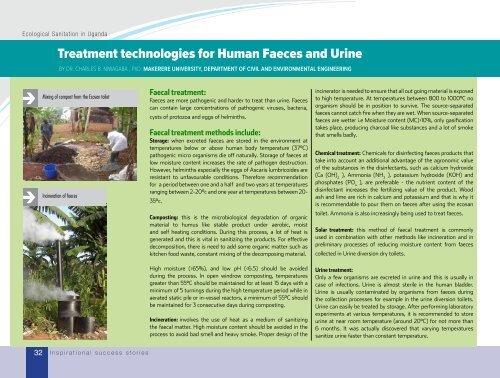
![Project Document [PDF: 2.31 MB] - EcoSanRes](https://img.yumpu.com/51279385/1/184x260/project-document-pdf-231-mb-ecosanres.jpg?quality=85)

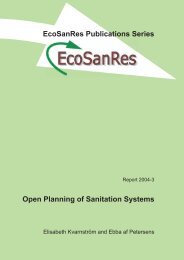

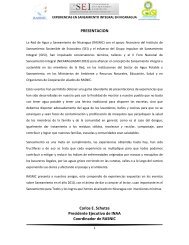
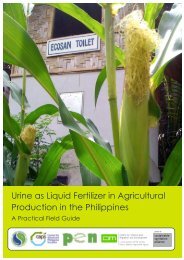







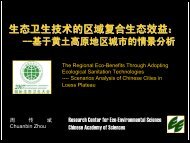
![Latrines à compost [high-resolution colour PDF: 12.3MB] - EcoSanRes](https://img.yumpu.com/31726141/1/185x260/latrines-a-compost-high-resolution-colour-pdf-123mb-ecosanres.jpg?quality=85)